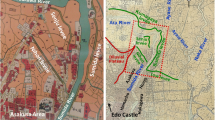Abstract
Due to their retention capacity, extensive flat floodplains have a significant impact on the propagation and transformation of flood waves. The conveyance and retention capacity of an area is significantly influenced by land use. The paper presents results of a hydraulic analysis of the impact of land use on the run-off regime in a retention area and consequently on flood wave propagation. The land use of the retention area was simulated by hydraulic roughness. The simulations were performed for flood waves with different values of peak discharge and with two lengths of duration. A spectrum of flood waves in which the retention areas have significant impact on the propagation was considered. To isolate the impact of topographical characteristics of riparian and retention areas on the communication of water between the channel and retention area, as well as on the formation of parallel streams in the area, a theoretical modelling area with simplified geometry was used in the first phase. Conclusions based on the results of the first-phase simulations were tested on a practical case of the plain Krško–Brežiško polje, where data from field measurements as well as data from the physical model were used in the numerical calibration of the model.














Similar content being viewed by others
References
Andersen BG, Rutherfurd ID, Western AW (2006) An analysis of the influence of riparian vegetation on the propagation of flood waves. Environ Model Softw 21(9):1290–1296
Calder IR (2006) Forest and floods: moving to an evidence-based approach to watershed and integrated flood management. Water Int 31(1):87–99
Chow VT (1959) Open channel hydraulics. McGraw-Hill, New York
Fathi-Moghadam M, Drikvandi K (2012) Manning roughness coefficient for rivers and flood plains with non-submerged vegetation. Int J Hydraul Eng 1(1):1–4
Fu-chun W, Hsieh WS (1999) Variation of roughness coefficients for un submerged and submerged vegetation. J Hydraul Eng 125(9):934–942
Ghavasieh A-R, Poulard C, Paquier A (2006) Effect of roughened strips on flood propagation: assessment on representative virtual cases and validation. J Hydrol 318:121–137
Helmio T (2002) Unsteady 1D flow model of compound channel with vegetated floodplains. J Hydrol 269(1–2):89–99
Hill CJ (2010) The role of floodplains on the propagation of land management signals in the Vale of York. Durham University, Durham
Järvelä J (2002) Flow resistance of flexible and stiff vegetation: a flume study with natural plants. J Hydrol 269:44–54
Järvelä J (2004) Determination of flow resistance caused by non-submerged woody vegetation. Int J River Basin Manag 2(1):61–70
Jongman B, Kreibich H, Apel H, Barredo JI, Bates PD, Feyen L, Gericke A, Neal J, Aerts JCJH, Ward PJ (2012) Comparative flood damage model assessment: towards a European approach. Nat Hazards Earth Syst Sci 12:3733–3752
Kundzewicz ZW (2009) Non-structural flood protection and sustainability. Water Int 27(1):3–13
Lhomme J, Gutierrez Andres J, Weisgerber A, Davison M, Mulet-Marti J, Cooper A (2010) Testing a new two-dimensional flood modelling system: analytical tests and application to a flood event. J Flood Risk Manag 3(1):33–51
Liu Q, Qin Y, Zhang Y, Li Z (2015) A coupled 1D–2D hydrodynamic model for flood simulation in flood detention basin. Nat Hazards 75:1303–1325
Mays LW (editor in chief) et al (1999) Hydraulic design handbook. McGraw-Hill, New York
Mertens W (2006) Hydraulisch-sedimentologische Berechnungsverfahren naturnah gestalteter Fließgewässer – Berechnungsverfahren für die Ingenieurpraxis. DWA, Hennef
Nisbet T (2004) Interactions between floodplain woodland and the freshwater environment. For Res Annu Rep Acc 2004–2005:32–39
Pasche E, Rouve G (1985) Overbank flow with vegetatively roughened flood plains. J Hydraul Eng 111(9):1262–1278
Patro S, Chatterjee C, Mohanty S, Singh R, Raghuwanshi NS (2009) Flood inundation modeling using MIKE FLOOD and remote sensing data. J Indian Soc Remote Sens 37:107–118
Rak G, Müller M, Šantl S, Steinman F (2012) The use of hybrid hydraulic models in the process of hydropower plants design on the lower Sava. Acta Hydrotech 25(42):59–70
Republic Slovenia (2007) Rules on methodology for determination of hazard and risk areas, Official Gazette of the Republic of Slovenia, nr. 60/2007: 3216
Samantaray D, Chatterjee C, Singh R, Kumar Gupta P, Panigrahy S (2014) Flood risk modeling for optimal rice planning for delta region of Mahanadi river basin in India. Nat Hazards 76:347–372
Šantl S, Novak G, Rak G, Steinman F (2010) Hybrid hydraulic modelling approach in the process of hydropower plant design. In: International symposium on hydraulic physical modelling and field investigation. China, Nanjing, pp 54–61
Schober B, Hauer C, Habersack H (2015) A novel assessment of the role of Danube floodplains in flood hazard reduction (FEM method). Nat Hazards 75:S33–S50
Sholtes JS, Doyle MW (2011) Effect of channel restoration on flood wave attenuation. J Hydraul Eng 137(2):196–208
Thomas H, Nisbet TR (2007) An assessment of the impact of floodplain woodland. Water Environ J 21(2):114–126
Valentova J, Valenta P, Weyskrabova L (2010) Assessing the retention capacity of a floodplain using a 2D numerical model. J Hydrol Hydromech 58(4):221–232
Vanderkimpen P, Melger E, Peeters P (2009) Flood modeling for risk evaluation—a MIKE FLOOD vs. SOBEK 1D2D benchmark study. Flood Risk Management: Research and Practice, pp 77–84
Williams L, Harisson S, O’Hagan AM (2012) The use of wetlands for flood attenuation. Report for An Taisce. Ireland, Cork, University College Cork, Aquatic Services Unit
Author information
Authors and Affiliations
Corresponding author
Rights and permissions
About this article
Cite this article
Rak, G., Kozelj, D. & Steinman, F. The impact of floodplain land use on flood wave propagation. Nat Hazards 83, 425–443 (2016). https://doi.org/10.1007/s11069-016-2322-0
Received:
Accepted:
Published:
Issue Date:
DOI: https://doi.org/10.1007/s11069-016-2322-0




